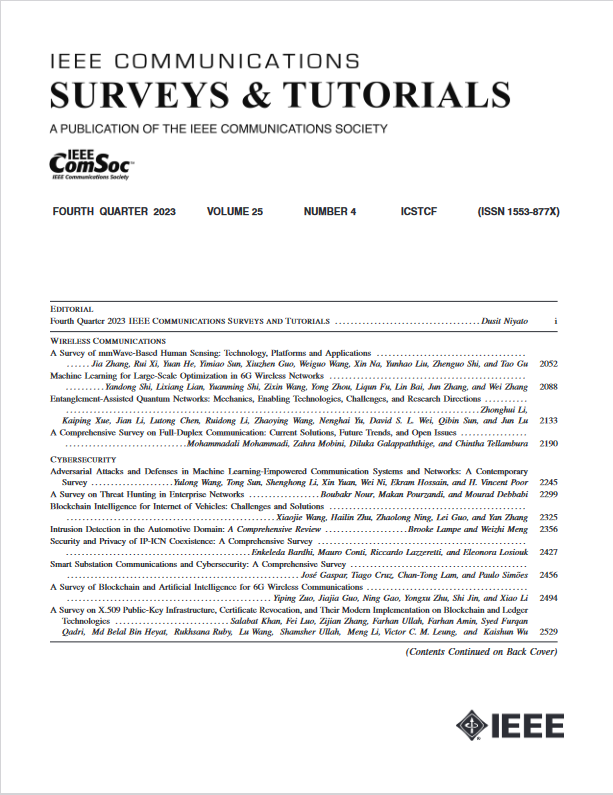Models, Methods, and Solutions for Multicasting in 5G/6G mmWave and Sub-THz Systems
IF 34.4
1区 计算机科学
Q1 COMPUTER SCIENCE, INFORMATION SYSTEMS
引用次数: 0
Abstract
Multicasting in wireless access networks is a functionality that, by leveraging group communications, turns out to be essential for reducing the amount of resources needed to serve users requesting the same content. The support of this functionality in the modern 5G New Radio (NR) and future sub-Terahertz (sub-THz) 6G systems faces critical challenges related to the utilization of massive antenna arrays forming directional radiation patterns, multi-beam functionality, and use of multiple Radio Access Technologys (RATs) having distinctively different coverage and technological specifics. As a result, optimal multicasting in these systems requires novel solutions. This article aims to provide an exhaustive treatment of performance optimization methods for 5G/6G mmWave/sub-THz systems and discuss the associated challenges and opportunities. We start by surveying 3rd Generation Partnership Project (3GPP) mechanisms to support multicasting at the NR radio interface and approaches to modeling the 5G/6G radio segment. Then, we illustrate optimal multicast solutions for different 5G NR deployments and antenna patterns, including single- and multi-beam antenna arrays and single- and multiple RAT deployments. Further, we survey new advanced functionalities for improving multicasting performance in 5G/6G systems, encompassing Reflective Intelligent Surfaces (RISs), NR-sidelink technology, and mobile edge enhancements, among many others. Finally, we outline perspectives of multicasting in future 6G networks.5G/6G 毫米波和 sub-THz 系统中的多播模型、方法和解决方案
无线接入网络中的组播是一种利用群组通信的功能,对于减少为请求相同内容的用户提供服务所需的资源量至关重要。在现代 5G 新无线电(NR)和未来的亚太赫兹(sub-THz)6G 系统中支持这一功能面临着严峻的挑战,这些挑战与利用大规模天线阵列形成定向辐射模式、多波束功能以及使用具有明显不同覆盖范围和技术特性的多种无线接入技术(RAT)有关。因此,这些系统中的最佳组播需要新颖的解决方案。本文旨在详尽论述 5G/6G 毫米波/次 THz 系统的性能优化方法,并讨论相关的挑战和机遇。我们首先介绍了第三代合作伙伴计划(3GPP)在 NR 无线电接口上支持组播的机制,以及 5G/6G 无线电段的建模方法。然后,我们说明了针对不同 5G NR 部署和天线模式的最佳组播解决方案,包括单波束和多波束天线阵列以及单 RAT 和多 RAT 部署。此外,我们还介绍了用于提高 5G/6G 系统组播性能的新型高级功能,包括反射智能表面 (RIS)、NR 侧联技术和移动边缘增强技术等。最后,我们概述了未来 6G 网络中的组播前景。
本文章由计算机程序翻译,如有差异,请以英文原文为准。
求助全文
约1分钟内获得全文
求助全文
来源期刊

IEEE Communications Surveys and Tutorials
COMPUTER SCIENCE, INFORMATION SYSTEMS-TELECOMMUNICATIONS
CiteScore
80.20
自引率
2.50%
发文量
84
审稿时长
6 months
期刊介绍:
IEEE Communications Surveys & Tutorials is an online journal published by the IEEE Communications Society for tutorials and surveys covering all aspects of the communications field. Telecommunications technology is progressing at a rapid pace, and the IEEE Communications Society is committed to providing researchers and other professionals the information and tools to stay abreast. IEEE Communications Surveys and Tutorials focuses on integrating and adding understanding to the existing literature on communications, putting results in context. Whether searching for in-depth information about a familiar area or an introduction into a new area, IEEE Communications Surveys & Tutorials aims to be the premier source of peer-reviewed, comprehensive tutorials and surveys, and pointers to further sources. IEEE Communications Surveys & Tutorials publishes only articles exclusively written for IEEE Communications Surveys & Tutorials and go through a rigorous review process before their publication in the quarterly issues.
A tutorial article in the IEEE Communications Surveys & Tutorials should be designed to help the reader to become familiar with and learn something specific about a chosen topic. In contrast, the term survey, as applied here, is defined to mean a survey of the literature. A survey article in IEEE Communications Surveys & Tutorials should provide a comprehensive review of developments in a selected area, covering its development from its inception to its current state and beyond, and illustrating its development through liberal citations from the literature. Both tutorials and surveys should be tutorial in nature and should be written in a style comprehensible to readers outside the specialty of the article.
 求助内容:
求助内容: 应助结果提醒方式:
应助结果提醒方式:


